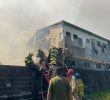After the Maguindanao massacre that killed 31 journalists on November 23 this year, the Philippines has surpassed war-torn Iraq as the world’s most dangerous place for journalists.
UPLM lost two lawyer-colleagues in the carnage that claimed women and even innocent motorists among its victims. Arroyo’s loyal political wards in Maguindanao, the powerful Ampatuan family, was accused of masterminding and implementing the massacre, with the help of the military, police and paramilitary forces in Maguindanao. The Ampatuans was crucial in Arroyo’s presidential win in 2004 and those of her senatorial bets in 2007.
“The Number 1 warlord in the country is the fake administration of Gloria Arroyo,” UPLM’s Zarate said during the rally. Onstage was a big plastic tarpaulin bearing the words, “Never Again to Martial Law!” “Uusigin, Patalsikin huwag Patakasin!”
Printed on the tarp was a target board with the face of Arroyo and Datu Unsay Mayor Andal Ampatuan Jr., the mayor charged with multiple counts of murder for the massacre that killed 57 people in Ampatuan town in Maguindanao on November 23. The tarp also showed the faces of top Arroyo advisers and members of her inner circle, that included Eduardo Ermita, Norberto Gonzales, Raul Gonzalez, Reynaldo Puno and retired general Jovito Palparan.

(davaotoday.com photo by Jose Hernani)
Palparan had earned the moniker ‘The Butcher’ among activists because of the increased incidence of unsolved extrajudicial killings in the places where he had been assigned. Palparan, who seeks a senatorial seat next year, had told the Davao media last week he will base his election campaign in this city, raising fear among groups this might worsen human rights situation in the region.
The human rights group Karapatan noted an average of 89 human rights violations victims each day between January to November 30 this year in Southern Mindanao. The cases documented included extrajudicial and political killings, frustrated extrajudicial killings, abduction, arbitrary arrest, torture, harassment, threats, intimidation, use of public places for military purposes, endangerment of civilians, indiscriminate firing and bombing, physical assault and injuries. It also included the use of civilians as guide during military operations, forcible evacuation and displacement, forced recruitment and conscription to paramilitary groups, and violation of children’s rights to protection and safety.
These violations have occurred mostly in the areas in the region where heavy militarization were punctuated by government’s “development” projects; such as large scale destructive mining operations, big agribusiness plantations, among others.
Oplan Bantay Laya
Kelly Delgado, secretary general of Karapatan in Southern Mindanao said the government’s program Oplan Bantay Laya, intended to end the insurgency next year, is a “national policy for state terrorism.”
“This has been proven further with the human rights situation in the region,” Delgado said.
Delgado called the Eastern Mindanao’s 10th Infantry Division as Arroyo’s “prime killing machine.” He said civilians bear the brunt of military operations, as the government’s Oplan Bantay Laya program indiscriminately targets both armed and unarmed resistance. Karapatan documented 116 cases of extrajudicial and political killings since 2001 in the region, adding up to 1,118 the number of victims since Arroyo came to power.










